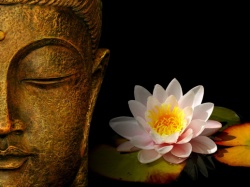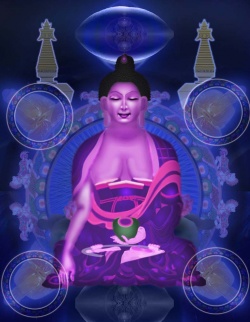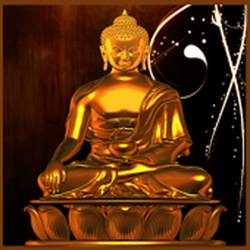Precepts sans the Preceptor & Apocrypha
Precepts sans the Preceptor & Apocrypha
By Indrajala (Jeffrey Kotyk)
In the Chinese Buddhist canon there are two notable scriptures which allow an individual under certain conditions to receive bodhisattva precepts without a physical preceptor present. This is unique because instead of receiving the bodhisattva precepts from a master one receives them from the unmanifest buddhas of the ten directions.
The Sūtra of the Jewelled Primary Activities of Bodhisattvas (Chn. Pusa Yingluo Benye Jing 菩薩瓔珞本業經) is one text which expressly gives the aspirant consent to receive the precepts without a physical preceptor under certain conditions. See the following.
- 《菩薩瓔珞本業經》卷2〈7 大眾受學品〉:「佛子。受戒有三種受。一者諸佛菩薩現在前受。得真實上品戒。二者諸佛菩薩滅度後。千里內有先受戒菩薩者。請為法師教授我戒。我先禮足應如是語。請大尊者。為師授與我戒。其弟子得正法戒。是中品戒。三佛滅度後千里內無法師之時。應在諸佛菩薩形像前。胡跪合掌自誓受戒。應如是言。我某甲白十方佛及大地菩薩等。我學一切菩薩戒者。是下品戒。」(CBETA, T24, no. 1485, p. 1020, c4-12)
- Sons of the Buddha! In receiving the precepts there are three types of reception. The first is receiving them before physically present buddhas and bodhisattvas. One receives truly high disposition precepts. The second is where after the buddhas and bodhisattvas have passed away, if there is within a thousand miles a bodhisattva who has received the precepts, one requests them to be a Dharma Master to teach and transmit to one the precepts. One first pays respects at their feet and should speak such: "Please great venerable one, act as a master to transmit to me the precepts." The disciple then obtains the precepts of the True Dharma. These are middle disposition precepts. The third is when after the Buddha has passed away and there is no Dharma Master within a thousand miles one should go before images of buddhas and bodhisattvas. Kneeling and with hands folded one makes vows and receives the precepts by oneself. One should speak as such: "I (name) respectfully address the buddhas of the ten directions and bodhisattvas of the great earth. I am one who will practice all bodhisattva precepts." These are the lower disposition precepts.
This is not unlike the Brahma Net Sūtra which also expressly allows for self-ordination.
- 《梵網經》卷2:「若佛子。佛滅度後。欲心好心受菩薩戒時。於佛菩薩形像前自誓受戒。當七日佛前懺悔。得見好相便得戒。若不得好相。應二七三七乃至一年。要得好相。得好相已。便得佛菩薩形像前受戒。若不得好相。雖佛像前受。戒不得戒。若現前先受菩薩戒法師前受戒時。不須要見好相何以故。以是法師師師相授故。不須好相。是以法師前受戒即得戒。以生重心故便得戒。若千里內無能授戒師。得佛菩薩形像前受戒而要見好相。」(CBETA, T24, no. 1484, p. 1006, c5-15)
- You sons of the Buddha! After the Buddha has passed when one has a good attitude and mind desiring to receive the bodhisattva precepts, one may go before images of the Buddha and bodhisattvas to make vows and receive the precepts alone. One should practise confession for seven days in front of the Buddha. It is when one witnesses auspicious signs that the precepts have been obtained. If one does not attain auspicious signs, then one must after fourteen or twenty-one days, or even up to a year, attain auspicious signs. When the auspicious signs have been attained, one then may go before the images of the Buddha and bodhisattvas to receive the precepts. If one does not attain auspicious signs, then even if one receives the precepts before a Buddha image, the precepts will not [really] have been obtained. If there is physically present one Dharma Master who has previously received the bodhisattva precepts and one then goes before them to receive the precepts, then there is no need to witness auspicious signs. Why? It is because the Dharma Master's masters have successively transmitted them. There is no need for auspicious signs. Therefore, going before the Dharma Master to receive the precepts one obtains the precepts. This is because having produced a serious mind one thus obtains the precepts. If within a thousand miles there is no master who can transmit precepts, one then goes before images of the Buddha and bodhisattvas to receive the precepts, though one must witness auspicious signs.
As to what these "auspicious signs" (Chn. hao xiang 好相) are, they are defined as follows in the text:
- 《梵網經》卷2:「好相者。佛來摩頂見光見華種種異相。」(CBETA, T24, no. 1484, p. 1008, c17)
- Auspicious signs are various odd signs such as the Buddha rubbing one's head, seeing light and seeing flowers.
Needless to say, this is a mystic's approach to spiritual practice. However, I suspect there is something behind the mention of having no preceptor available and thus the need for a means to receive precepts while also stipulating conditions.
The translation of the Brahma Net Sūtra is attributed to Kumārajīva 鳩摩羅什 (344–413 CE), though this may or may not be the truth. Likewise, the translation of the Sūtra of the Jewelled Primary Activities of Bodhisattvas is attributed to Zhu Fonian 竺佛念 (4th cent.), though it is speculated that it was produced in China. Nevertheless, one thing that comes to mind when I look at these two texts is that they appear before the first translations of the Vinaya were available. The Vinaya, the formal disciplinary code for bhikṣu monks, was first translated into Chinese only in the early 5th century. Until then whether or not China had many fully-ordained bhikṣus or not is unclear. What is clear though is that bodhisattva precepts could be available to anyone due to texts like the Brahma Net Sūtra.
Individuals capable of transmitting precepts of any kind, whether they be for bhikṣus or bodhisattvas, were probably quite few and far between. The need for having a means to receive precepts without having a preceptor present was probably apparent in this general time period. Consequently, a means to receive the precepts was provided in the aforementioned texts. That being said, the Vinaya precepts cannot be received without preceptors.
Interestingly, both of the aforementioned scriptures are thought to be, as it were, "apocryphal" in the sense of having been composed in China rather than in India. In reality a lot of the most popular scriptures in East Asian Buddhism have turned out to have arisen in China rather than in India or elsewhere. In fact, even the Heart Sūtra is suspected of having been composed outside of India. It was Jan Nattier who put forth this theory. You can read more about it at Jayarava's blog here.
One reason why so-called apocryphal scriptures might have become so popular is because they arose out of local conditions, concerns and needs, rather than those of some distant culture long ago. As I just mentioned, the need for a means to receive precepts and practise them, which would have been a concern for many Buddhist devotees who lacked access to preceptors, was curiously included in two scriptures from a time when just such concerns existed. This is perhaps the beauty of revelatory literature in that it arises out of local and present circumstances rather than being literature transmitted from another time and place and having to be reinterpreted to fit in present circumstances.
This is exactly what Mahāyāna literature of the past largely was. No matter where it came from, it clearly reflects the circumstances and times from which it comes from. It adapts to time, people and places. Even if the two scriptures cited above arose in China, why would they be any less valuable or acceptable than those from India?
Finally, one question that should be addressed is from who these revelatory scriptures came from. Of course, the literature itself has the Buddha giving a teaching and historically most individuals would have asserted it was the flesh and blood Śākyamuni Buddha who taught this teaching. However, in our present day it is thought otherwise. You will hear scholars speak of these scriptures "being written" like a novel.
The other day I was speaking about just this with some monks here in Taiwan. My opinion is that much Mahāyāna literature was the result of visions, and I have touched on this before elsewhere on this blog. In the early days of Buddhism the Mahāsāṃghika saw the Buddha as transcendental and consequently it was from said school that the Mahāyāna primarily arose from. In such an environment it is easy to imagine yogis having profound visions of the transcendental Buddha providing teachings, writing them down and such accounts becoming canonical. Likewise, as the Mahāyāna developed it became possible for some scriptures to be specifically known as revelatory, such as Asaṅga receiving the Mahāyāna-sūtrālamkāra-kārikā from Maitreya Buddha in a vision. This same thing could have occurred in China as well. This is why I feel scriptures "produced" in China (or anywhere for that matter) as just as valid as those from India.
There is indeed a kind of genuine sincerity to be found in this kind of literature. Wherever it came from, the individuals responsible for first putting it down on paper were clearly concerned with the spiritual welfare of others. By providing a means to practise precepts without a preceptor, they did a great service to those devotees in remote lands lacking dharma teachers.



